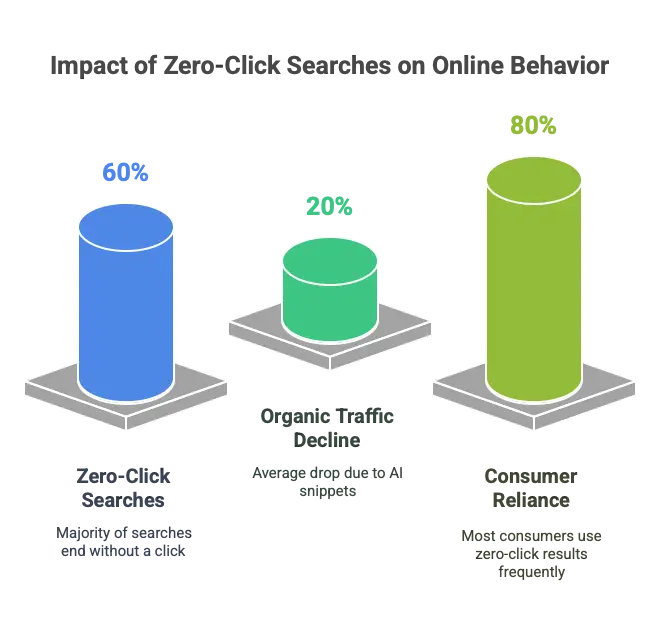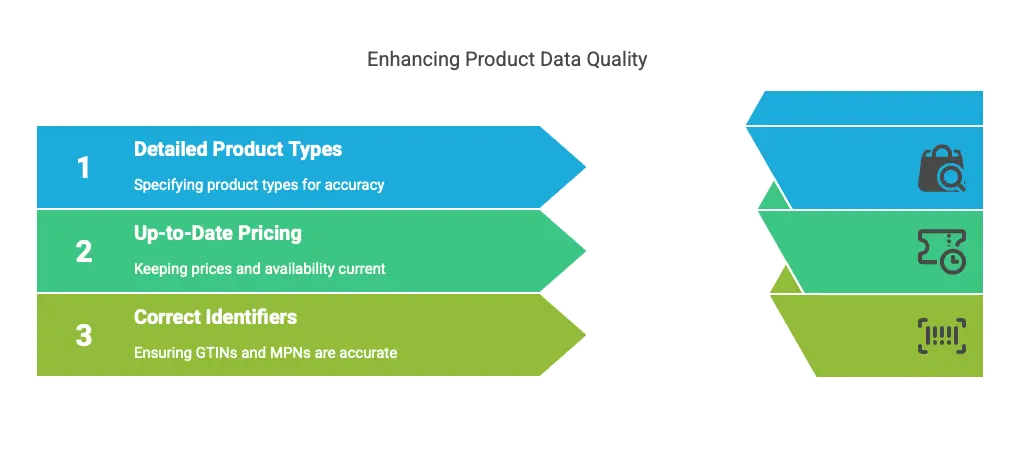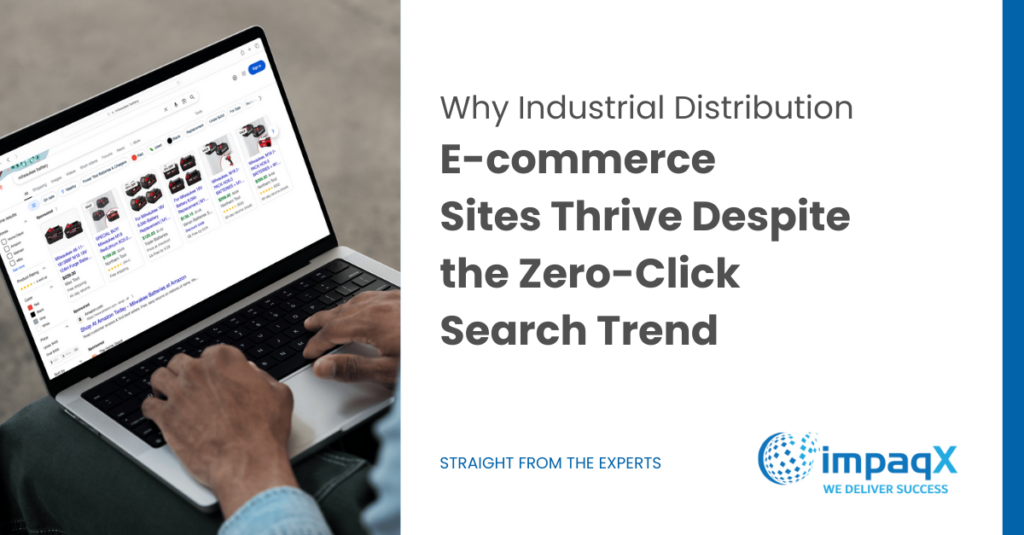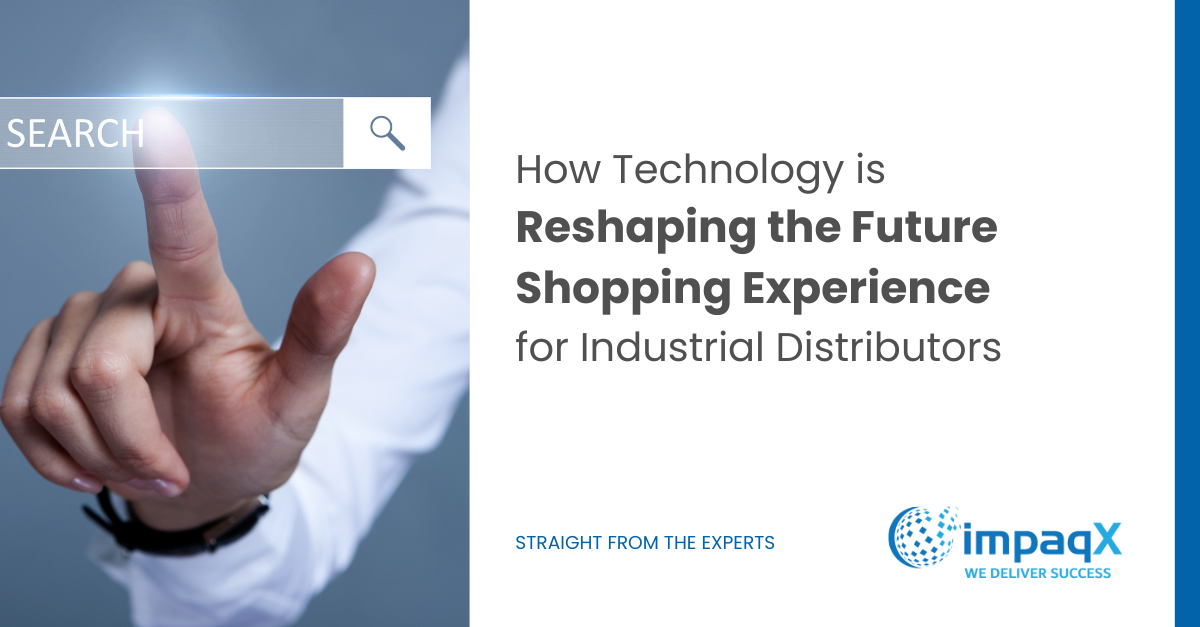Digital Marketing Insights

Dan Bronson
Partner, Marketing / SEO / Analytics
“Is this the end of organic traffic?” If you’ve been monitoring the rise of AI-powered search features and zero-click results, you’re not alone in asking this. I have had multiple clients approach me concerned about the impact of decreasing use of Google and zero-click searches will have on their industrial distribution e-commerce site.
The good news? E-commerce sites with extensive product catalogs—especially in the B2B industrial distribution space—are far less vulnerable to this shift than pure content websites. By doubling down on product structured data and optimizing your Google Merchant Center feed, you can actually turn this trend into an advantage.
In this post, we’ll explore:
- What zero-click search really means and why it’s rising
- Why large-scale industrial e-commerce sites are naturally more resilient
- How to harness product structured data for maximum SERP visibility
- Strategies for Google Merchant Center that drive clicks and conversions
- Tactical content approaches tailored to high-intent B2B buyers
- Real-world case studies proving these techniques work
Whether you manage thousands of SKUs or oversee multiple regional distribution centers, read on for actionable insights that will not only assuage your fears, but help you thrive in the zero-click era.
Understanding the Zero-Click Search Landscape
What Is Zero-Click Search?
Zero-click search refers to queries where users find the answer they need directly on the search engine results page (SERP), without clicking through to any external link. AI-generated summaries, featured snippets, and instant answers mean that in many cases, Google—or another search engine—becomes the final destination.
The Rising Tide of Zero-Click
- Nearly 60% of U.S. and EU Google searches now end without a click, according to research by Search Engine Land (2024 Zero-Click Study).
- Organic traffic across industries has declined by an estimated 15–25% since AI snippets gained prominence, as highlighted in Bain & Company’s analysis of search behavior.
- 80% of consumers rely on zero-click results for at least 40% of their queries, based on a Bain & Company consumer survey.
These shifts have sent SEO teams scrambling, particularly in content-heavy industries where informational queries once drove substantial site visits.

Why Large-Scale E-commerce Sites Are Less Affected
Transactional Intent vs. Informational Queries
Zero-click features impact informational searches far more than transactional ones. When users are explicitly looking to buy—searching for “buy industrial compressor” or “stainless steel fasteners pricing”—they still tend to click through to compare options, pricing, and availability. According to Search Engine Land, transactional searches experience minimal erosion in click-through rates.
“The good news for e-commerce businesses is that transactional searches are far less affected by zero-click searches.”
Complexity of B2B Purchases
For industrial distributors, purchases are rarely impulse buys. Buyers need detailed specifications, compatibility guides, and volume discounts. A simple SERP snippet cannot satisfy these needs:
- 85% of B2B buyers complete their vendor shortlist before even initiating a search, according to industry research.
- Complex configurations and bulk-order options demand a full site visit—and zero-click results simply can’t replace in-depth product pages.
This inherent complexity gives industrial distribution e-commerce sites a natural edge in a world increasingly dominated by AI-centric search interfaces.
Harnessing Product Structured Data for Visibility
Why Structured Data Matters
Structured data markup tells Google exactly what each element of your product page represents—price, availability, reviews, GTINs and more. In a zero-click context, this can be the difference between appearing in a rich product snippet or getting buried under an AI summary.
Types of Product Structured Data
| Structured Data Type | Purpose | When to Use |
| Product Snippets | Highlights key details (price, availability, reviews) | For standard product pages where purchase occurs offline or via call-to-action (Google’s guide to product structured data). |
| Merchant Listings | Enables inclusion in Google Shopping and free product lists | For pages where direct purchase (cart or buy button) is available (Google Merchant Center specification). |
Table: Comparison of Product Snippet vs. Merchant Listing structured data.
Best Practices for Implementation
- Use JSON‑LD format for easier maintenance and Google compatibility, as outlined in Google’s Structured Data Documentation.
- Include all critical fields: name, image, description, price, availability, review ratings, GTIN, MPN, and brand.
- Validate your markup using Google’s Rich Results Test.
- Keep your data fresh—update prices, stock levels, and lead times regularly.
Implementing these practices ensures your products qualify for rich features like carousels, knowledge panels, and featured snippets—even as zero-click rates climb.

Maximizing Google Merchant Center Opportunities
Google Merchant Center (GMC) is often overlooked by B2B distributors, but it can be a goldmine for both paid and free product listings.
Ensuring Data Accuracy and Completeness
Per Google’s recommendations in their Product Data Specification:
- Provide the most detailed product type values to improve matching accuracy.
- Maintain up-to-date price and availability, including tax and delivery info.
- Ensure GTINs and MPNs are correct, especially for branded industrial products.
Accurate GMC feeds not only boost your presence in Google Shopping, but also enhance visibility in standard search carousels.

GTIN Implementation and Benefits
Global Trade Item Numbers (GTINs) are particularly impactful:
“Retailers who’ve added correct GTINs to their product data have seen a 20% increase in clicks on average.”
With proper GTINs:
- Your products surface more often in free listings, paid ads, YouTube shopping hubs, and partner sites.
- Google better understands product variants, so your inventory shows up in more relevant searches.
Strategic Content Approaches for Industrial Distributors
Despite the zero-click shift, content remains king—especially content that aligns with high purchase intent and the technical needs of your audience.
Focusing on High-Intent Queries
- Target long-tail, transactional queries like “stainless steel ball valve 3/4” full port” rather than “ball valves.”
- Optimize page titles and headers with these phrases, and include clear calls-to-action above the fold.
Leveraging Technical Content and Thought Leadership
Publishing deep-dive resources helps you capture buyers earlier in their decision process:
- Comparison guides (e.g., side-by-side pump performance charts).
- ROI calculators (e.g., energy savings over time).
- Installation/specification walkthroughs for complex machinery.
An industrial pump distributor created detailed comparison guides and earned featured snippets for 45+ high-value technical queries, while preserving click rates for transactional searches.
Local SEO for Distribution Centers
With supply-chain disruptions top of mind, local searches are booming. To capture regional B2B traffic:
- Create location-specific landing pages (e.g., “Chicago hydraulic hose distributor”).
- Embed Google Maps and customer testimonials for each center.
- Optimize your Google Business Profile with industrial-specific categories and attributes.
Case Studies and Real-World Success Stories
Company | Strategy | Result |
Industrial Fastener Distributor | Comprehensive product markup + bulk pricing tiers | 24% increase in product visibility; 17% higher CTR |
Electrical Components Distributor | GTIN enrichment + real-time inventory updates | 20% more clicks; 35% higher conversion from Shopping |
Industrial Pump Specialist | Technical content series + ROI calculators | Featured snippets for 45 queries; maintained CTR |
Table: Success metrics from industrial distribution e-commerce leaders.
These examples demonstrate that even in a zero-click world, well-executed technical and transactional strategies drive both visibility and engagement.
Conclusion and Next Steps
Zero-click search may feel threatening—but it’s simply evolution. For industrial distribution e-commerce sites with thousands of products:
- Double down on product structured data to claim rich SERP features.
- Optimize your Google Merchant Center feed with accurate GTINs, pricing, and availability.
- Develop targeted, high-intent content that speaks directly to technical B2B buyers.
- Leverage local SEO to capture regional demand and build brand trust.
By embracing these tactics, you’ll turn zero-click trends into opportunities for greater visibility, higher click-through rates, and ultimately, stronger sales. Ready to get started? Audit your product markup today, update your GMC feed, and watch your industrial distribution e-commerce site come out ahead in the zero-click era.

